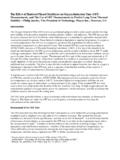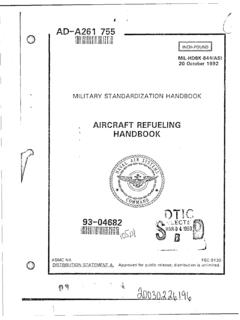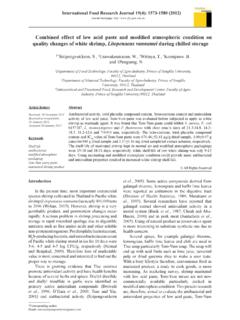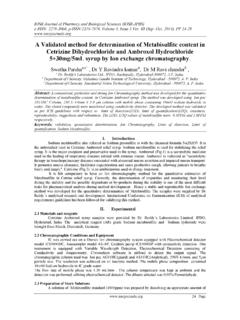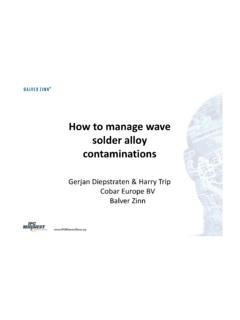Transcription of Measurement of Hydroquinone - Health and Safety …
1 Harpur Hill, Buxton Derbyshire, SK17 9JN. T: +44 (0)1298 218000. F: +44 (0)1298 218590. W: Measurement of Hydroquinone HSL/1998/02. Author: Emma Scobbie Science Group: Environmental Measurement Crown copyright (1998). SUMMARY. OBJECTIVES. The aim of this project was to investigate a method for the Measurement of Hydroquinone in air, in order to be able to demonstrate compliance with the proposed occupational exposure limit (OEL). MAIN FINDINGS. As Hydroquinone may occur in both the vapour and particulate phases, effective sampling requires a combination of a particle collector and a vapour collector.
2 The sampler evaluated was a glass fibre filter contained in a multi-holed sampler which collects the particulate backed up with a tenax tube to collect any vapour. The samples were desorbed into acetonitrile and analysed by High Performance Liquid Chromatography (HPLC). This method was shown to be effective at measuring Hydroquinone over the range to 2 times the target exposure limit of mg/m3 for 8 hours. MAIN RECOMMENDATIONS. The following recommendations are made for sampling and analysis of airborne Hydroquinone ;. SAMPLING - Air samples are taken onto glass fibre filters with back-up tenax tubes at a flow rate of 2 l/min.
3 ANALYSIS - The filters and tenax tubes are immediately desorbed into acetonitrile and analysed by HPLC. CONTENTS. PAGE. 1. INTRODUCTION 1. 2. OVERVIEW OF THE PROJECT 1. 3. EVALUATION PROCEDURE 2. 4. ANALYTICAL METHOD 2. 5. Measurement RANGE 3. 6. EVALUATION OF METHOD FOR Hydroquinone 3. Determination of desorption efficiency 3. Experimental 3. Results 3. Conclusions 4. The effect of temperature, humidity and concentration - preliminary study 4. Experimental 4. Results 5. Conclusions 6. The effect of temperature, humidity and concentration - further experiments 6.
4 Experimental 6. Results 7. Conclusions 7. Storage 8. Experimental 8. Results 8. Conclusions 10. 7. OVERALL UNCERTAINTY 10. 8. FIELD TRIALS 11. Field trial 1 11. Field trial 2 11. 9. DISCUSSION AND CONCLUSIONS 12. 10. REFERENCES 13. APPENDIX 1 DETECTION AND QUANTIFICATION LIMITS 15. 1. INTRODUCTION. The main purpose of this work was to investigate methods for measuring personal exposure to Hydroquinone and to demonstrate the adequacy of the developed method to cope with proposed occupational exposure limits. The target occupational exposure limit (OEL) was taken as mg/m3 (8 hour time weighted average, TWA).
5 Exposure to Hydroquinone can cause skin irritation and sensitisation, and irritation to the eyes, nose and throat (HSC, 1995). Hydroquinone has also been shown to be mutagenic in animals and a no-adverse-effect-level cannot be identified in humans. Acute poisoning can cause dizziness, headache, unconsciousness, low temperature, tinnitus, breathing difficulties and a fast or feeble pulse. Hydroquinone is classified on the Approved Supply List (Chemicals (Hazard Information and Packaging) Regulations, 1994) as harmful and is labelled with risk phrases R20 and R22 : harmful by inhalation and if swallowed.
6 Hydroquinone is likely to occur in both the vapour and particulate phases in some atmospheres (Perez and Soderholm, 1991). It is subject to auto-oxidation in the presence of trace amounts of oxygen and can be oxidised easily in the presence of water vapour to form benzoquinone which is more volatile than Hydroquinone . It is also oxidised when exposed to light. Hydroquinone is used as a developer in black and white photography; an antioxidant for fats and oils; a polymerization inhibitor; a stabilizer in paints, varnishes, motor fuels, oils; an intermediate for rubber-processing chemicals; in the production of mono- and dialkyl-ethers.
7 And as a depigmenting agent. In the photographic industry exposure to Hydroquinone dust and solutions may occur during the manufacture of developers, and exposure to aerosols and mists containing Hydroquinone may occur during bottle-filling. In other industries Hydroquinone dust in the air is the major source of potential exposure. Although some methods to measure exposure to Hydroquinone have been published in the literature they have not been used by HSE and have not been fully validated. 2. OVERVIEW OF THE PROJECT. A search of the literature indicated several possible methods for the Measurement of Hydroquinone (Gattrell and Kirk, 1987; Huang et al, 1984; Levin, 1988; NIOSH, 1984.)
8 Risner, 1990; Risner and Cash, 1990). Hydroquinone may occur in both the vapour and particulate phases in some atmospheres (Perez and Soderholm, 1991) and the possibility also exists for oxidation to benzoquinone, present in vapour form. MDHS 14/2 (HSE, 1997). recommends personal samplers for total inhalable dust. Only one of the methods found in the literature (Levin, 1988) involves sampling for both vapour and particulate, but does not use a sampler recommended in MDHS 14/2 or distinguish between Hydroquinone and benzoquinone. 1. The multi-orifice sampler recommended in MDHS 14/2 was used in this study, containing a glass fibre filter at a flow rate of 2 l/min.
9 A back-up adsorbent tube was used behind the filter head to collect any Hydroquinone or benzoquinone which may be present in the vapour phase. Analysis was carried out by High Performance Liquid Chromatography (HPLC). 3. EVALUATION PROCEDURE. The performance of the samplers was tested under a range of conditions using the European testing protocol BS EN 482 for guidance. 4. ANALYTICAL METHOD. Samples were collected at 2 l/min onto glass fibre filters contained in multi-orifice heads according to MDHS 14 (HSE, 1997) with back-up tubes containing Tenax (50/100mg, dimensions 8x100mm).
10 The samples were desorbed into acetonitrile (3ml) and analysed by HPLC using a Zorbax CN column (25cm x ). The flow rate through the column was ml/min. Hydroquinone was measured at 290 nm and benzoquinone at 245 nm. The spectra are shown in Figure 1. Choice of mobile phase Acetonitrile : water A 30:70 acetonitrile : water mobile phase was found to give effective separation of Hydroquinone ( mins) and benzoquinone ( mins). However, conversion of Hydroquinone to benzoquinone appeared to be taking place in the system. The extent of this conversion varied with the concentration of Hydroquinone , the amount of conversion being greater in the lower concentration Hydroquinone standards.










